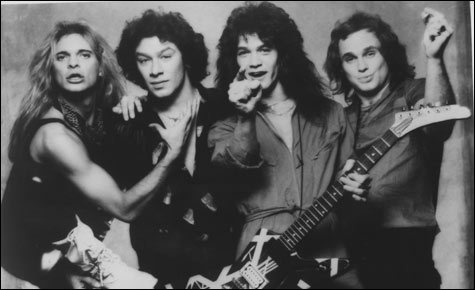
CARTOON GODS: There was a hilarity in the heart of the Van Halen sound.
|
Good news from the literary delivery room: the ignoble genre of rock biography — mother of the rush job, the as-told-to, the hack encomium and the maniac screed — has just given birth to its first genuine comedy. Written in jubilant, elastic prose, Ian Christe’s Everybody Wants Some: The Van Halen Saga (Wiley) is a sort of Day-Glo fairy tale, in which a pair of bold young brothers take big chances for great rewards, and the Seven Deadly Sins circle with no more menace than the Seven Dwarves. The book’s first paragraph bears reprinting in its entirety:
Like the stories of other great Americans from Henry Ford to Walt Disney to Fievel the Mouse, the saga of Van Halen begins in an ancient land, far from the United States and its constant supply of hot water and electricity. As a narrator would say in the old movies: Among the windmills, tulips, and wooden shoes of lovely Amsterdam, Holland, there once lived a kindly musician named Jan van Halen.
. . . And Jan’s sons Alex and Eddie, one a thumper of drums and the other a note-spewing guitar prodigy, would one day be in “the ultimate sunshine hard rock band,” where a creature called Roth would torment them for years until they hired a strange curly buffoon called Sammy. And then another guy called Cherone. And . . . and . . .
They were nearly called Mammoth. It was vocalist David Lee Roth’s idea to name the band after the two Dutch brothers — an airy, propellent name. A brand name, as it turned out. They came out of the mid ’70s playing dense, earthbound, blues-based party rock, but there was a hilarity in the heart of the Van Halen sound, a kind of nitrous-oxide delight that kept them in permanent midair. The noise they made was American/Olympian: cartoon gods at their sport. Eddie’s big-bang creativity was the first thing you heard, launched up and out by the jazzy aggression of his brother’s drumming; then David Lee Roth and his weird wheeze of a hard-rock scream — almost soundless, like a lion yawning; and lastly the plod-plod and the dead-on helium harmonies of bassist Michael Anthony. Knowing what he had in front of him, Ted Templeman produced the band with Albini-esque rigor — high definition, no overdubs, nothing that couldn’t be reproduced on stage. Dwindling in their wake was the ass-crack ’70s boogie of Mountain and Foghat. Ahead was punk, speed metal, possibility.
Van Halen’s bizarro or anti-band were Black Flag, captained by another introverted guitar loony (Greg Ginn) and with a similarly rotating cast of frontmen (four, as against VH’s three). But if the two acts were LA’s rock-and-roll antipodes, the open, horizontal nature of the city ensured that there were points of contact — this was show biz, after all. Marshall Berle (real-life nephew of Uncle Miltie), who brokered Van Halen’s signing to Warner Bros. in 1977, later played a managerial role for Black Flag. And David Lee Roth was a closet devotee of LA punk. By 1984, according to Christe, Roth was acting as “unofficial top-secret sugar daddy” for the Zero Club, a punk-rock dive where he met and mingled with the likes of Henry Rollins and the Minutemen’s Mike Watt. As Christe puts it, in this company Diamond Dave was “bingeing on inspiration.” Zero barman Top Jimmy was celebrated on Van Halen’s 1984 (“Top Jimmy cooks!/Top Jimmy swings!/He’s got the look!/Top Jimmy! Woo!/Shake it baby!”), and Rollins would one day collaborate with Dave in the production of Dave’s memoir Crazy from the Heat.
Diamond Dave, as every child knows, was not the lead singer of Van Halen forever. In 1985, maddened by his vanity, his mania, his martial arts, his “surgically implanted disco beat,” and his habit of banging on their hotel-room doors at nine in the morning looking for a roller-skating partner, the brothers gave him the boot. Dave’s insufferability is something East Coast radio audiences were apprised of when he (briefly) took over Howard Stern’s spot last year. What a disaster that was. Four months of Dave bigmouthing away and grunting “Nh! Show me!” to his in-studio guitarist before the suits at CBS put the whole thing out of its misery. (Christe comments gently that Dave’s “loosely organized rants seemed ill-suited for high-powered morning drive-time radio.”) But as Dave was to Howard, so Sammy was to Dave: beneath his beach-ball cheeriness, Van Halen’s second singer was a ruthless agent of mediocrity, and he brought them down. Sammy Hagar could probably sing better than David Lee Roth, but without Dave’s raddled, ironic, Bing-Crosby-on-Aquanet croon, the whole thing fell to pieces very fast. (Quality-wise, that is. They remained a commercial juggernaut.)